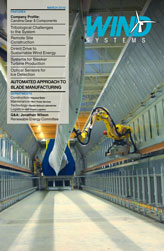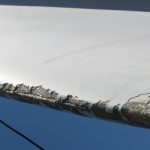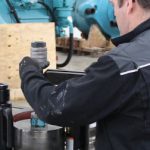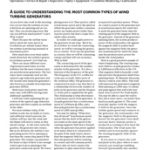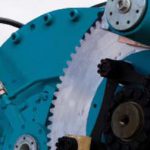Just as airplanes, refrigerators, radio broadcast towers, vehicular overpasses, and bridges are all succeptible to ice formation, so are wind turbines that are sited in cold-weather locations. And not only do O&M professionals monitoring remote turbines need to be aware of the onset of ice formation, they also need to know how fast it’s accumulating.
The most common type of ice detector on the market today involves a vibrating tuning fork sensor, whose design dates from the 1980s. It is essentially an electromechanical technology that operates as a vibrating rod. In the case of an airplane, the rod is mounted so as to be exposed to the passing airstream. If there’s no ice on the vibrating rod, it resonates at its natural frequency. But if it has a coating of ice the additional weight slows down the vibrations, which changes the frequency. The frequency change is detected, then calibrated into ice weight, and ice thickness, and subsequently used to set the ice-alert signal after a predetermined thickness has accumulated on the probe, usually around 0.020 inch.
Unfortunately, such complex assemblies have lots of precision internal parts, are costly to manufacture and put together, are not very sensitive, and require a high-speed ambient air stream in order to work properly. The interface electronic package, of course, has to be integral with the vibrating assembly, which limits installation flexibility and also its suitability for use on wind power turbines.
Another snow/ice sensing system is popular on helicopters. It consists of a toroid assembly that senses numerous ambient meteorological conditions to infer the presence or absence of ice. It also needs a high-speed ambient air stream to work properly, and also is not entirely suitable for use on wind power turbines.
Looking for Ice
To solve the ice detection problem, New Avionics has introduced its new Ice*Meister™ Model 9734 optical ice sensing system for use on top of wind power turbine nacelles (fig. 1). It’s entirely optical—there are no moving parts. Model 9734 system consists of a small, easy to install sensor head that sits on a mounting plate atop the nacelle as it looks for ice. A lightweight blue cable connects the sensor head to a DIN rail interface box that is mounted on an interior bulkhead or snapped onto a standard 35mm DIN rail inside the nacelle. Inside the DIN enclosure box an Ice*Meister Model 9733-CORE user interface board monitors the probe status, drives corresponding display LEDs, controls an optional self-defrosting heater, senses and displays whether or not it’s raining, and provides one-amp normally open relay contacts that close or open in real time to inform its host system of the foregoing status elements, as well as the real-time presence or absence of ice on the nacelle.
As ice accumulates additional relays close in sequence, indicating the ice’s relative accumulation rate. Three relays’ open-or-closed states define four states of ice on the nacelle: no-ice; ice-alert; more-ice; and saturation-ice. Subsequently, as sunlight and warming ambient air heats and melts the accumulated ice away the relay sequence reverses itself, opening in reverse order: saturation-ice; more-ice; ice-alert; and no-ice. There are also provisions to control a defrost heater and indicate when it’s raining.
The user interface DIN rail box fascia panel provides convenient screw-terminals for connecting wires to the sensor head, the host system, and input power. Visible LEDs in the fascia panel let you test the sensor system at any time and view the resulting ice status at virtually any angle inside the nacelle (fig. 2).
Ice*Meister’s principle of operation is to allow ice to form directly on its optical surfaces. Imagine an analogous situation during the hot summertime, when a motorist may be driving along a highway to a destination with the car’s air conditioner blowing full blast into the driver’s face and sunglasses. When the driver arrives at a destination and steps out of the car into the hot ambient air, condensation can form immediately and directly on the optical surfaces of the sunglasses. The effect is immediate, easily recognizable, needs no interpretation, and can be very sensitive. This is how the Ice*Meister sensor works; offending ice forms directly on its optical surfaces.
Photons vs. Molecules
In operation, the system is based the physical interaction between photons of light and molecules of H2O. The technology is not in any way an analog measurement instrument, and it does not measure ice thickness. Rather, it uses photons of light to sense the digital step-function phase change of H2O molecules between their liquid and solid phases across the thermal barrier known as “latent heat of fusion,” which is 80 calories per gram of water.
If H2O molecules are in the liquid state (water) the force of gravity tends to remove them from the sensor surface, and only a thin film of H2O molecules separates the sensor surface from the ambient air. This film of H2O molecules interposes itself between the excitation signal and the receiver and is electrically zeroed out. If, however, the H2O molecules are in the solid phase (ice) they tend to stick together for some reason and accumulate on the sensor surface. This increases the number of H2O molecules interposed between the optical surface and the receiver, thus attenuating the excitation signal below a set threshold. It is this threshold-passing function that Ice*Meister detects. Thus, ice-formation sensing is a digital step-function and has nothing to do with thickness, temperature, or time.
The ice sensing go/no-go thresholds are fixed, but both excitation signal strength and the amplifier gain are trimpot-adjustable over wide ranges. If the adjustments are set to sensitive (low excitation signal drive, high amplifier gain) the threshold is tripped with only a little ice on the sensor (fig. 4), but if the the adjustments are set to less sensitive (strong excitation drive, low amplifier gain) it takes more ice to trip the detector threshold.
Either clear ice or opaque rime ice can form on the sensor. If clear ice forms it reacts with the sensor in one way, and if opaque rime ice forms it reacts with the sensor in another. Either rime or clear ice will register, but air will not. Rime ice trumps clear ice, and ice of either kind trumps air.
System Options
Ice*Meister optional features include a rain sensor, a self-defrosting heater, and a protective cage. Model 9734’s rain sensor feature is used for controlling protective doors on celestial telescopes, watering golf courses, controlling agricultural sprinkler systems, and the like. Ice*Meister can sense individual raindrops, which fall at terminal velocity and impact the sensor, producing 5-10 millisecond pulses each. An onboard raindrop-stretcher timer stretches raindrops to 15-30 seconds each in duration, sets the rain status true, illuminates the rain LED, and closes the rain relay. If a second raindrop should hit the sensor before the first one times out, it resets the timer for another 15-30 seconds. For as long as raindrops continue to hit the sensor at intervals closer than that, the rain output status remains true.
A self-defrosting heater feature rids the sensor probe of offending ice and allows its host system to cycle back-and-forth across the ice formation threshold. Gravity eliminates the icemelt. This features is useful for centralized meteorological towers, webcams, walkways, radio towers, and oil wells, as well as weather stations, power stations, telescopes, bridges, blimps, and all manner of remote, inaccessible, unmanned facilities.
A resistance heater and thermal switch are affixed to heater panels on either side of the sensor probe. Insulating epoxy potting compound assures maximum radiant heat is directed toward the optical sensor probe. Temperatures of the ice-melting aluminum heater panels are limited to a mild 50 deg C for personnel safety. 9734’s heater feature requires only 1.2 A at 24 VDC. The entire 9734 system consumes just two watts, running on 12-36 VDC.
Heater control can be set to maintain either the least amount of ice or consume the least amount of energy. In operation, this feature allows its host control system to cycle back-and-forth across the ice formation threshold in real time, preventing protected facilities from accumulating ice and using the least amount of energy to do it.
9734’s optional protective cage (fig. 5) helps protect the sensor probe from potential damage from falling debris, including chunks of melting ice falling from a stationary blade as it heats up and sheds ice in the warmth of day. The cage is widely open on four sides and provides abundant airflow around and over the sensor head. It’s transparent to the sun’s rays, allowing the sensor head to heat and cool as the turbine blades do, and roughly track them thermally throughout the day. The cage is unobtrusive, because its mounting bracket and protective roof are made of clear, shatterproof polycarbonate plastic. The assembly does not interfere with a nacelle’s esthetic appeal.
NASA Tested
Ice*Meister ice sensing technology is simple, optical, and eliminates all moving parts. There is no microcontroller, no MHz clock, and no programming of any kind required. Model 9734 ice sensor systems for wind power turbine nacelles are optically the same as the Model 9732 stainless steel aerospace probes that New Avionics tested in the world’s largest icing wind tunnel, the Icing Research Tunnel at NASA Glenn in Cleveland, Ohio fig. 6
These aerospace ice sensors, available in both stainless steel and plastic, are designed for use in aircraft of all kinds, including unmanned aerial vehicles. They conform to core paragraph 5.2.1.1.1 of the only published aerospace specification for in-flight ice detectors (Aerospace Standard AS 5498 from the Society of Automotive Engineers) and they are listed, described, and illustrated in the SAE Aerospace Information Report AIR 4367A, paragraph 4.11.
The fast growing and rapidly evolving U.S. wind industry has broken all previous records by adding some 10,000 MW of additional capacity in 2009 alone, which brings the total installed capacity to more than 35,000 MW of generating power from more than 33,000 individual turbine installations, according to AWEA. Most of these turbines stand in northern latitudes and are susceptible to ice formation. Although most earlier ice sensing technologies are generally unsuitable for use on wind power installations, new optical ice sensors work in still air and can help fill the void.



















